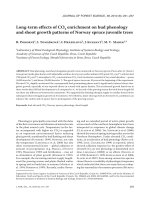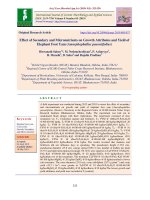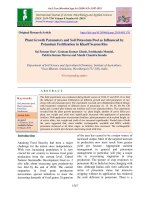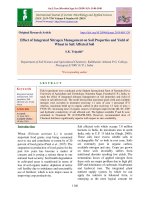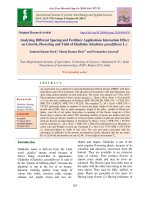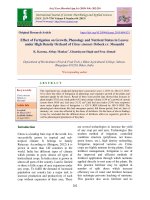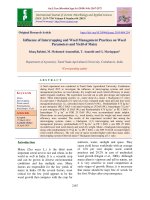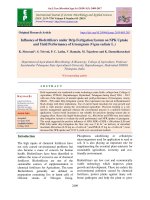Impact of plant growth regulators on growth, phenology and yield characters of hybrid rice
Bạn đang xem bản rút gọn của tài liệu. Xem và tải ngay bản đầy đủ của tài liệu tại đây (153.26 KB, 8 trang )
Int.J.Curr.Microbiol.App.Sci (2019) 8(1): 838-845
International Journal of Current Microbiology and Applied Sciences
ISSN: 2319-7706 Volume 8 Number 01 (2019)
Journal homepage:
Original Research Article
/>
Impact of Plant Growth Regulators on Growth, Phenology and yield
Characters of Hybrid Rice
Pawan Kumar Goutam1*, S.P. Kushwaha1, Dharmadew Chauhan2,
Vikas Yadav1 and Subhash Kumar1
1
Department of Crop Physiology, 2Department of Biochemistry, College of Agriculture, C.S.
Azad University of Agriculture & Technology, Kanpur -208 002, India
*Corresponding author
ABSTRACT
Keywords
Foliar application,
GA3, IAA, NAA,
Triacontanol
(TRIA), Cycocel,
Growth parameters,
Phenology,
Nitrogen content in
straw (%), Yield,
Hybrid rice
Article Info
Accepted:
07 December 2018
Available Online:
10 January 2019
The influence of foliar applied plant growth regulators on rice crop was
conducted on hybrid rice crop during kharif season’s 2015 and 2016.
Application of five growth regulators each in two concentration viz., GA3
20 and 40 ppm, IAA 25 and 50 ppm, NAA 10 and 20 ppm, Triacontanol 5
and 10 ppm, Cycocel 3000 and 4000 ppm and one unsprayed control with
foliar sprays at tillering and flowering stages for growth, yield parameters.
The observation was recorded at different stages of crop. Higher
concentration of IAA produce maximum dry biomass, increased the total
leaf area plant-1, total number of leaves at different crop growth stages,
CCC delayed flowering and maturity, IAA produced higher nitrogen
content in straw (%) and grain yield plant-1 (g) over control (T1).
Introduction
Rice is one of the staples food crop in India
and most of country, its food provide energy,
carbohydrate, proteins, vitamins consumed by
majority of the population. World rice
production 490.8 million metric tonnes and
India rice production 109.7 million metric
tonnes in year 2016-17 (USDA 2018). In India
rice play key role it contributes also 46% of
Indian cereal production and also staple food
for two third of the population. India has
433.88 lakh hectares in area and production
104.32 million tones in year 2015- 16 (DAC&
FW 2016-17). National Food Security Mission
target of 3 million hectares, area under hybrid
rice continue to range from 1.8 to 2.0 million
hectares in the last few years. Hybrid rice
plays a most important role for increase is
yield in unit area. The yield advantage of 15-
838
Int.J.Curr.Microbiol.App.Sci (2019) 8(1): 838-845
20% over the best pure line varieties (6.5 t ha-1
as against 5.4 t ha-1) proved the key factor for
wide adoption of the hybrid rice technology.
Plant growth regulators play an essential role
in regulating plant growth and development.
Growth regulator is only needed in small
amounts to determine the course of
physiological
processes,
growth,
differentiation, and development (Davies,
1995).
year (Table 1) result indicated that maximum
total dry biomass was recorded with the IAA
50 ppm followed by TRIA 5 ppm and others
treatment of PGRs also give better response at
30, 60, 90 DAT and at maturity stages of crop
in both the years 2015 and 2016. These
findings are in conformity to Aldesuquy H.S.
(2001), Prajapati et al., (2017).Who obtained
similar improvement in dry matter production
by leaves and stem by the use of IAA and
TRIA.
Materials and Methods
Research experiment on impact of foliar
applied plant growth regulators on growth
parameters and yield of hybrid rice (PHB-71)
was conducted during Kharif season 2015 and
2016, in Randomized Block Design with three
replications at Student Instructional Farm at
C.S. Azad University of Agriculture and
Technology Kanpur, The experiment carried
out with foliar application of five growth
regulators each in two concentration, total
eleven treatment as GA3 20 and 40 ppm, IAA
25 and 50 ppm, NAA 10 and 20 ppm,
Triacontanol 5 and 10 ppm, Cycocel 3000 and
4000 ppm and control which were replicated
three times, two foliar spray was done at
tillering and at flowering time with sprayer.
Nitrogen content in rice leaves was estimated
by using instrument, semi- auto nitrogen
analyzer of model KEL PLUSH. These
instrument works on the principal of kjeldahl
method of nitrogen analysis. Different
observations were recorded as Total dry
biomass of plant (g), Total leaf area plant-1,
Total number of leaves plant-1, at different
stages. Days to 50 % flowering, days to
maturity, nitrogen content in straw (%), Grain
yield plant-1 (g).
Results and Discussion
The dry matter production is mainly due to
higher translocation efficiency of assimilates
source to sink, in pooled analysis over two
A morphological and important yield
supporting character i.e. total leaf area plant-1
showed in (Table 2) that the pooled analysis
over two year data maximum found with IAA
50 followed by TRIA 5 ppm. Others plant
growth regulators also enhance the total leaf
area plant-1 in comparison to control in both
the years 2015 and 2016. Finding was
supported by Panday et al., (2001), Sutedja
(1993).
In pooled analysis over two year data (Table
3) showed that total numbers of leaves was
highly produced with the treatment of IAA 50
ppm as compare to TRIA 5 ppm in different
growth stages. Other growth hormones are
also increases total number of leaves in rice
crop in both years 2015 and 2016. Finding
supported by Tripathi (1978), Prajapati et al.,
(2017).
Days to flowering and maturity pooled
analysis over two year data (Table 4) indicated
that CCC 3000 and 4000 ppm give late
flowering and maturity of the crop in both the
year 2015 and 2016 strongly supported by
Mehrotra et al., (1983), Dighe et al., (1985),
Sexana et al., (1988). IAA and other treatment
also delayed flowering and maturity with the
observation of Pandit et al., (1986), Rajendra
and Jones Jonathan (2009). Treatment of GA3
caused early flowering supported by Naeem et
al., (2004), Awan et al., (1999) and Iilium Lee
et al., (1999) in both the year in rice crop.
839
Int.J.Curr.Microbiol.App.Sci (2019) 8(1): 838-845
In pooled analysis over two year data showed
that the maximum nitrogen content in straw at
maturity stage showed (Table 4) was mainly
affected by the foliar spray of IAA 50 ppm
followed by lower dose of IAA 25 ppm. Other
hormones in different concentrations also
accelerating the nitrogen value in straw. This
result is favor by the discussion given by Patil
et al., (1989), Prajapati et al., (2017).
Plant hormones increased the grain yield
plant-1 (g) in pooled analysis over two year
data (Table 4) indicate the highly produced by
the foliar spray of IAA 50 ppm followed by
TRIA 5 ppm, others treatments in different
concentration also effective in producing
grain yield plant-1. This conclusion was
favored by Hussen (2011), Borowaski et al.,
(2000),
Choi
et
al.,
(2010).
Table.1 Impact of various growth regulators on Total dry biomass of Hybrid Rice at different
crop growth Stages
Total dry biomass (g)
Treatments
30 DAT
60 DAT
90 DAT
Maturity
2015 2016 Pooled 2015 2016 Pooled 2015 2016 Pooled 2015 2016 Pooled
3.24 10.50 11.07 10.79 23.40 23.87 23.64 36.26 36.70 36.48
T1- Control 3.10 3.38
4.10 14.48 15.03 14.76 29.30 29.76 29.53 52.10 52.59 52.35
T2- GA3 20 3.88 4.31
ppm
4.35 15.60 16.12 15.86 30.27 30.79 30.53 54.78 55.13 54.96
T3- GA3 40 4.15 4.54
ppm
4.33 14.70 15.25 14.98 31.40 31.95 31.68 56.55 56.91 56.73
T4- IAA 25 4.12 4.53
ppm
4.79 16.41 16.92 16.67 33.10 33.61 33.36 61.70 62.06 61.88
T5- IAA 50 4.56 5.01
ppm
4.56 15.60 16.15 15.88 31.80 32.30 32.05 59.00 59.36 59.18
T6- TRIA 5 4.40 4.72
ppm
4.14 14.80 15.33 15.07 27.93 28.57 28.25 53.34 53.80 53.57
T7- TRIA 4.00 4.28
10 ppm
3.75 4.15
3.95 14.30 14.83 14.57 28.30 28.79 28.55 49.46 49.91 49.69
T8- NAA
10 ppm
4.22 14.87 15.40 15.14 29.20 29.70 29.45 50.90 51.36 51.13
T9-NAA 20 4.03 4.40
ppm
3.80 13.47 14.03 13.75 29.15 29.64 29.40 47.20 47.55 47.38
T10- CCC 3.60 3.99
3000 ppm
3.35 3.75
3.55 12.28 12.82 12.55 26.62 27.14 26.88 43.70 44.18 43.94
T11-CCC
4000 ppm
SE(d)
0.15 0.16
0.11
0.74 0.95
0.59
0.56 0.77
0.47
1.02 1.09
0.75
CD at 5% 0.33 0.34
0.22
1.54 2.00
1.19
1.17 1.60
0.96
2.13 2.27
1.50
840
Int.J.Curr.Microbiol.App.Sci (2019) 8(1): 838-845
Table.2 Impact of various growth regulators on Total leaf area plant-1 of Hybrid Rice at different growth Stages
Treatments
T1- Control
T2- GA3 20
ppm
T3- GA3 40
ppm
T4- IAA 25
ppm
T5- IAA 50
ppm
T6- TRIA 5
ppm
T7- TRIA 10
ppm
T8- NAA 10
ppm
T9-NAA 20
ppm
T10- CCC
3000 ppm
T11-CCC 4000
ppm
SE(d)
CD at 5%
Total leaf area plant-1
30 DAT
60 DAT
90 DAT
Maturity
2015
2016 Pooled
2015
2016
Pooled
2015
2016
Pooled
2015
2016
Pooled
178.20 187.48 182.84 786.55 909.45 848.00 1228.50 1397.65 1313.08 1058.40 1218.75 1138.58
264.69 332.58 298.64 1250.43 1405.53 1327.98 1853.77 2097.90 1975.84 1607.09 1865.43 1736.26
334.42
411.48
372.95 1477.98 1645.99 1561.99 2173.50 2394.00 2283.75 1888.11 2109.93 1999.02
359.10
446.22
402.66 1593.64 1771.71 1682.68 2303.32 2534.64 2418.98 2046.87 2287.01 2166.94
461.60
552.82
507.21 1846.68 2046.60 1946.64 2692.80 2877.67 2785.24 2409.41 2649.60 2529.51
375.87
458.28
417.08 1713.15 1905.98 1809.57 2412.48 2623.56 2518.02 2165.62 2392.32 2278.97
285.07
359.66
322.37 1521.45 1697.28 1609.37 2147.06 2362.08 2254.57 1927.80 2122.31 2025.06
252.45
314.21
283.33 1111.01 1252.02 1181.52 1643.98 1813.50 1728.74 1510.86 1669.50 1590.18
285.44
352.56
319.00 1085.04 1232.01 1158.53 1586.91 1780.80 1683.86 1450.08 1635.30 1542.69
303.52
368.25
335.89 1183.26 1328.29 1255.78 1723.57 1912.50 1818.04 1521.00 1702.99 1612.00
236.92
294.08
265.50 1022.40 1162.07 1092.24 1511.64 1576.57 1544.11 1319.76 1497.60 1408.68
12.17
25.41
13.08
27.30
8.93
18.06
99.11
206.82
162.15
338.36
95.01
192.03
841
62.94
131.34
97.33
203.12
56.70
114.45
158.73
284.06
153.50
320.33
100.18
202.22
Int.J.Curr.Microbiol.App.Sci (2019) 8(1): 838-845
Table.3 Impact of various growth regulators on total number of leaves of hybrid rice at different
growth Stages
Total number of Leaves
Treatments
30 DAT
2015
2016
60 DAT
Pooled
2015
2016
90 DAT
Pooled
2015
2016
Maturity
Pooled
2015
2016
Pooled
T1- Control 14.85 15.15
15.00
27.70 28.50
28.10
30.20 31.10
30.65
29.00 28.00
28.50
T2- GA3 20
ppm
17.30 18.10
17.70
33.50 33.10
33.30
37.10 38.30
37.70
36.10 37.90
37.00
T3- GA3 40
ppm
18.20 19.05
18.63
35.60 36.13
35.87
39.50 40.00
39.75
38.30 39.10
38.70
T4- IAA 25
ppm
19.00 20.10
19.55
36.62 37.14
36.88
40.30 40.80
40.55
39.20 40.05
39.63
T5- IAA 50
ppm
20.25 21.00
20.63
38.50 39.11
38.81
42.40 42.00
42.20
41.30 41.80
41.55
T6- TRIA 5 19.35 20.10
ppm
19.73
37.40 38.09
37.75
40.90 41.10
41.00
40.00 40.60
40.30
T7- TRIA
10 ppm
18.10 19.03
18.57
36.50 37.10
36.80
39.70 40.15
39.93
39.00 39.30
39.15
T8- NAA
10 ppm
16.50 17.10
16.80
31.50 32.10
31.80
35.70 36.00
35.85
34.80 35.00
34.90
T9-NAA 20 17.62 18.15
ppm
17.89
32.40 33.08
32.74
36.30 37.00
36.65
35.40 36.06
35.73
T10- CCC
3000 ppm
18.65 19.18
18.92
34.60 35.12
34.86
38.50 39.00
38.75
37.50 38.10
37.80
T11-CCC
4000 ppm
17.55 18.07
17.81
33.40 34.07
33.74
37.30 38.00
37.65
36.20 37.00
36.60
SE(d)
1.05
1.20
0.78
1.60
1.84
1.19
1.35
1.63
1.04
1.32
1.42
0.95
CD at 5%
2.19
2.51
1.57
3.35
3.85
2.41
2.89
3.41
2.11
2.76
2.97
1.92
842
Int.J.Curr.Microbiol.App.Sci (2019) 8(1): 838-845
Table.4 Impact of various growth regulators on 50 % flowering and maturity, Nitrogen content
in straw (%) and, grain yield plant-1 (g) of Hybrid Rice
2015
84.00
2016 Pooled 2015
85.00 84.00 130.00
Nitrogen content in
Grain yield plant-1 (g)
straw (%)
2016 Pooled 2015 2016 Pooled 2015 2016 Pooled
131.00 130.50
0.52
0.53 0.53 20.10 20.15 20.13
84.88
85.11
84.88
131.33
131.44
131.39
0.58
0.59
0.59
21.45
21.50
21.48
84.99
86.00
84.99
131.77
131.88
131.83
0.59
0.60
0.60
22.65
22.70
22.68
86.11
86.44
86.11
134.88
135.00
134.94
0.61
0.62
0.62
22.85
22.95
22.90
86.22
86.55
86.22
135.00
135.22
135.11
0.62
0.63
0.63
25.20
25.30
25.25
87.33
87.77
87.33
133.66
133.77
133.72
0.60
0.61
0.61
24.26
24.30
24.28
87.11
87.33
87.11
133.44
133.66
133.55
0.59
0.60
0.60
23.00
23.10
23.05
85.44
85.66
85.44
132.22
132.44
132.33
0.56
0.57
0.57
22.85
22.90
22.88
85.66
85.88
85.66
132.44
132.66
132.55
0.57
0.58
0.58
21.70
21.80
21.75
87.44
87.99
87.44
135.11
135.33
135.22
0.56
0.57
0.57
22.60
22.65
22.63
87.66
88.22
87.66
135.22
135.55
135.39
0.55
0.56
0.56
21.44
21.52
21.48
0.88
0.87
0.60
1.06
1.39
0.86
0.011
1.04
0.71
1.82
1.22
2.21
2.91
1.73
0.025
0.00
9
0.01
9
1.02
1.84
0.01
4
0.03
0
2.14
2.18
1.44
Treatments Days to 50% flowering
T1 Control
T2- GA3
20 ppm
T3- GA3
40 ppm
T4- IAA
25 ppm
T5- IAA
50 ppm
T6- TRIA
5 ppm
T7- TRIA
10 ppm
T8- NAA
10 ppm
T9-NAA
20 ppm
T10- CCC
3000 ppm
T11-CCC
4000 ppm
SE(d)
CD at 5%
Days to maturity
In conclusion foliar application of plant
growth regulators (PGRs) mainly IAA was
very effective for increasing dry biomass,
total leaf area plant-1, total number of leaves,
days to 50 % flowering and maturity, nitrogen
content in straw (%), grain yield plant-1 (g)
during both kharif years 2015 and 2016. The
treatments of hormones most effective for
physiological, morphological and yield
parameters in hybrid rice crop.
Acknowledgement
The author are thankful for financial
assistance by University Grant Commission,
Gov. of India, New Delhi under Rajiv Gandhi
National Fellowship (RGNF-2015-17-SCUTT-5033), and greatful to my advisory
chairman Dr. S.P. Kushwaha for better
guidance and supporting during my research
work.
843
Int.J.Curr.Microbiol.App.Sci (2019) 8(1): 838-845
Hussein, M. M. and Alwa, A. K. 2014. Effect
of zinc and absorbic acid application
pigments of millet plants grown under
different
salinity.
Agricultural
sciences, 5:1253-1260.
Mehrotra, O.N. 1983. Effect of growth
regulators on wheat Indian J. Agric.
Res. 17 (1/2):57-61.
Naeem, M., Bhatti. I., Ahamad, R.H. and
Ashraf, M.Y. 2004 Effect of low
temperature Stress in transplanted
Aman Rice varieties Mediated by
Different Transplantig dates, Acadmic
Journal of plant science 2 (3): 132138.
Pandey, N., Upadhyay, S. K., Tripathi, R. S.
2001.
Effect
of
plant growth regulators and fertility
levels
on growth and
yield
of
transplanted rice. Indian Journal of
Agricultural Research; 35(3): 205207. 7 ref.
Patil, B. N. and Dhomne, M. G., 1998.
Growth analysis and yied of sunflower
as influenced by growth retardant.
Annl. Physio., 12 (1): 29-31.
Prajapati, L., Kushwaha, S.P. and Singh, B.
A. 2017 Physiological assessment of
growth regulators on growth, yield
and quality traits of basmati rice
(Oryza sativa L.) Journal of
Pharmacognosy and Phytochemistry;
6(5): 164-166
Rajendra, B., Jones Jonathan D.G. 2009 Role
of plant hormones in plant defense
responses. Plant Molecular Biology,
69:473-488.
Saxena, H. K., Tripathi, R.S. and Singh, O.P.
1988. Effect of growth regulators on
crop efficiency and productivity of
gram (Cicer arietinum L.). Paper
presented at National Seminar on
Recent Advanced in plant growth
regulator research no. 17-19, 1988,
Jodhpur.
Sutedja, I. N. 1993. Growth of vanilla short
References
Aldesuquy, H.S., 2001. Efficiency of indole3- acetic acid on improvement of
some biochemical and physiological
aspects of Wheat flag leaf during grain
filling. Agrochimicia, 45(1/2); 1-13.
Awan, I.U., Baloch. M.S., Sadozai, N.S. and
Sulemani, M.Z. 1999 stimulatory
effect of GA3 and IAA on ripening
process Kernel development and
quality of rice Pakistan Journal
Biological Science; 2 (2): 410-412.
Borowaski, E., Blamowaski, Z.K., Michalek,
W. 2000 Effect of tomatoex/
triacontanol
on
chorophyll
fluorescence
and
tomato
(Lycopersicum esculentum Mill.)
yield, Acta Physiologiae Plantarum
22, 271-274.
Borowski, E. and Blamowski, Z.K., 2009.
The effects of triacontanol ‘TRIA’ and
Asahi SL on the development and
metabolic activity of sweet basil
(Ocimum basilicum L.) plants treated
with chilling. Folia Horticulturae Ann.
21(1): 39-48.
Choi, J. H., Abe, N., Tanaka, H., Fushimi, K.,
Nishina, Y., Morita, A., Kiriiwa, Y.,
Motohashi, R., Hashizume, D.,
Koshino, H. and Kawagishi, H. 2010.
Plant-growth regulator, imidazole-4carboxamide, produced by the fairy
ring formingfungus Lepista sordida. J.
Agric Food Chem., 58(18): 99569959.
DAC&FW (Annual Report 2016-17) Pp. 1-2
Davies, P.J. 1995. The plant hormones: Their
nature, occurrence, and functions. In
P.J. Davies (ed.) Plant hormones:
Physiology,
biochemistry
and
molecular biology. Kluwer Academic,
Dordrecht, Boston, London.
Dighe, R.S., Thakre, J.T. and Lal, S.S. 1985.
Panjabrao
Krishi
Vidhyapeeth
Research Journal: 7(2): 12-15.
844
Int.J.Curr.Microbiol.App.Sci (2019) 8(1): 838-845
stem cuttings promoted by rootone F
and Dharmasri 5 EC (in Indonesian).
Udayana
University
Scientific
Journal. 20 (38): 138 – 145.
U.S.D.A. Foreign Agriculture Service 2018.
World Agriculture Production. Pp. 14.
How to cite this article:
Pawan Kumar Goutam, S.P. Kushwaha, Dharmadew Chauhan, Vikas Yadav and Subhash
Kumar. 2019. Impact of Plant Growth Regulators on Growth, Phenology and yield Characters
of Hybrid Rice. Int.J.Curr.Microbiol.App.Sci. 8(01): 838-845.
doi: />
845
